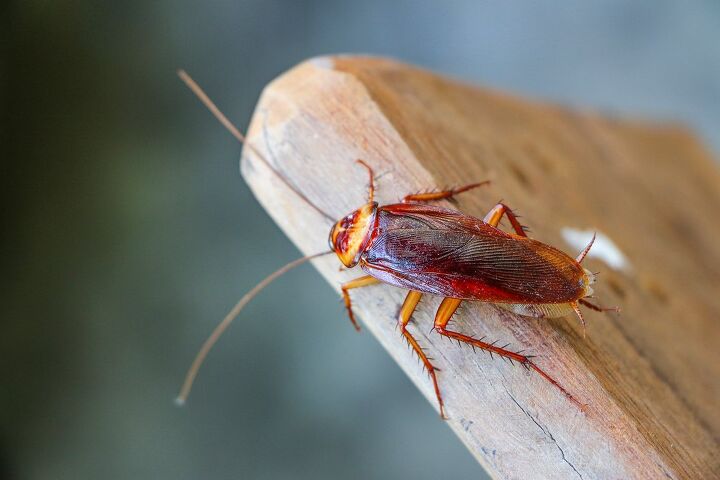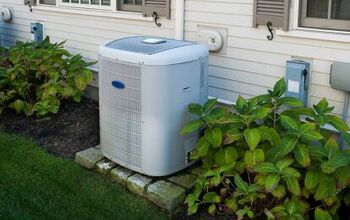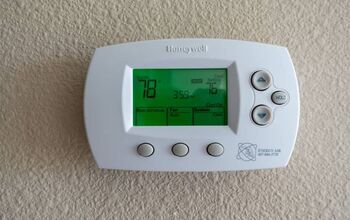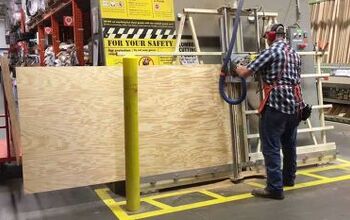9 Bugs That Look Like Cockroaches (With Photos)

Having been in a trap house-like apartment before, my heart sinks when I see small bugs that look like cockroaches. I actually double-check them to make sure that I don’t have a family of cucaracha in my casa. It’s actually kind of crazy to see how many bugs look like cockroaches. Wondering what the most common ones are?
Waterbugs, bed bugs, beetles, and crickets are the insects that look like cockroaches, but aren’t. It’s worth noting that palmetto bugs and faux “water bugs” are the same thing as cockroaches, but are used to describe Oriental roaches and Florida roaches respectively.
If you recently saw something that looks creepy and roach-y crawling around your home, you probably are curious about what they are and what you should do to get rid of them. This article is going to hopefully help you out on all fronts.
Do You Need Pest Control Services?
Get free, zero-commitment quotes from pro contractors near you.

Before You Begin: Please Make Sure It’s Not Roaches!
Yes, I know that this is an article about bugs that look like roaches. However, as a renter, I understand how bad a roach infestation can be. This is a good time to mention that I’m going to go into what bugs are not actually roaches and what bugs are, in fact, roaches.
Regardless of what you have, you need to consider calling an exterminator. A lot of the pests here are considered to be major health risks, especially if they are in your kitchen.
Bugs That Look Similar To Cockroaches
Alright, so we went over my disclaimer. Let’s talk a bit about what your bug could be before you panic.
1. Waterbugs
So, there are real waterbugs and fake ones. Real waterbugs are highly unlikely to be in your home, but it can still happen. The photo above is a picture of a real one. These have legs that are more paddle-like than an actual cockroach. They also tend to have rounder, flatter bodies.
Waterbugs, as the name suggests, are mostly found in water. (Shocking, I know.) Unlike roaches, these bugs can live up to 4 minutes underwater. You probably do not have these in your home unless you live next to a swamp. Or something. They also tend to grow far bigger than roaches, with a maximum length of four inches.
2. Bed Bugs
For your sake, I hope that this is not what you have in your home. This is a bed bug, and they are one of the only insects that actively, exclusively feast on people. They are notoriously hard to get rid of and can cause severe allergic reactions in some people. Bed bugs are going to be a nightmare to get rid of.
They are much smaller than roaches, which is why they are mistaken for baby roaches. They are small, flat, and light brown in most cases. If they just ate, they almost look like ticks and take on a deeper color. If you find these in your home, call an exterminator immediately.
3. Wood Boring Beetles
Everyone who sees wood-boring beetles tends to assume that they are cockroaches. These beetles tend to have a smaller size than a roach, and also may have yellow and white markings. As their name suggests, these beetles tend to live and eat wood.
If you have noticed strange bugs crawling out of newly-eaten holes in your wood, then you may have wood-boring beetles. This is a problem, since most houses are made of wood and they can cause structural damage in certain situations. Call an exterminator and grab some diatomaceous earth.
4. Longhorn and Palo Verde Beetles
So, I decided to put these two together because they look exactly like cockroaches to most people and because they act similar in nature. Both of these bugs are large, dark brown or black, and have noticeable antennas on their heads. (Longhorns, like the one pictured above in pupa and adult stages, have VERY long antennas.)
Though they look insanely similar to roaches, there is one major difference here: the size. These bugs are massive. Like, four to five inches long, massive. They like palo verde woods, rose bushes, and other plant life. People food doesn’t attract them, but occasionally, they will wander in homes and scare the shit out of people who live there.
Both of these beetles can be a bother to trees, to the point that they can actually kill them if too many start eating them. If you see these in your nearby forest, you might want to contact authorities to see if they can do anything.
5. Asian Longhorned Beetles
Asian longhorned beetles are not like most of the other beetles on this list, primarily because it’s highly unlikely that you’ll mistake them for roaches. However, stranger things have happened. These have stark black and white markings on their adult bodies. That’s what differentiates them as adults. As pupae, they’re pretty similar-looking to roaches.
For the most part, these bugs are not going to be harmful to humans. Trees, on the other hand? Yeah, they will kill them pretty quickly. Asian longhorn beetles, much like the beetles above this, tend to feast on trees that we really need to survive.
If you see these in your homes, squish them. If you see these on the trees near your home, call your local environmental office to see if they can spray down your trees.
6. Ground Beetle
Rounding out our bunch of beetles is the common ground beetle. These bugs look a lot like black roaches, with the exception that they tend to have “teeth” on their heads. These tend to have blacker markings than cockroaches, and are more likely to just make burrows near your home. They are not big into indoor life.
Like almost all other beetles, these bugs are strictly vegetarian. So, they are not going to cause an infestation in your home. If you see one wandering about, catch it and let it outside. Or squish it. I’m not going to tell you what to do on that front.
7. May Beetles/June Bugs
If you grow strawberries or other plants outside, you already are well-acquainted with these pests. May beetles, also commonly known as June bugs, are a pest that loves to eat up fruits and vegetables during the hot summer months. They also tend to look like really small cockroaches with a more “bubbled” appearance.
The good news about these is that they don’t like to stay indoors and that you can usually get rid of them by letting them fly (clumsily) away. These bugs do not like the indoors since there is no vegetation there to eat, and they also don’t bore holes in wood. Unless you left out moldy potatoes in your cellar, there’s no need to panic.
The bad news is that your vegetable garden probably will want to have a word with you if you don’t install a June bug trap near it.
8. Crickets
Crickets run the gamut from the tiny and green to the large and brown. It’s the large and brown ones that people tend to mistake for roaches—at least from far away. Obviously, there are a couple of major differences here. These tend to have larger back legs and differently-shaped heads.
Of course, the biggest difference is the noise they make. Cockroaches are either silent or make an awful hissing noise. Crickets make a chirping noise by rubbing their legs together. If you find crickets in your home, then you might have an issue. Crickets love dampness and might actually propagate in basements.
Diatomaceous earth is a good way to get rid of them. There are also some cricket traps you can use in order to get rid of them en masse.
9. Termites
This is a bit of a stretch, sure, but it’s still something that could be mistaken for a cockroach if you are partially blind or see them from afar. These are termites, and they are actually pretty different from roaches. I mean, they’re a lot smaller than roaches are (unless they are young) and have disproportionately larger heads with pincers on the front of them.
Termites are not a good thing to see in your home, primarily for the same reason that wood-boring beetles aren’t a good thing. These bugs are notorious for eating wood structures, especially if it’s dried wood…like the stuff that your home is made out of.
If you have termites, it’s best not to try to fix this yourself. You may need to call an exterminator and your homeowner’s insurance company. In some cases, the infestation could have caused a bit of structural damage to your house.
Nicknames For Roaches (That Are Often Assumed Not To Be Roaches)
Now that we’ve gone over the basics of other bugs that you could have instead of cockroaches, it’s time to take a closer look at the bugs that are technically cockroaches. After all, roaches aren’t just known as roaches. A roach by any other name is still a roach.
1. “Waterbugs”
So, this is a bit confusing for many people. Waterbugs are a legit group of insects that are not roaches. They exist on water. Cockroaches, though, are often called waterbugs. This is particularly true when we’re talking about Oriental cockroaches, like the ones pictured above.
Real waterbugs are going to have paddle-like legs and will not hiss at you. Moreover, they also do not like staying in houses. Cockroaches love damp (but not watery) environments. If you hear someone tell you that it’s a waterbug and the “waterbug” hisses, call an exterminator. You’ve got roaches.
2. Palmetto Bugs
While the term “waterbug” tends to suggest that you have Oriental roaches, the term “Palmetto bug” tends to suggest that you have American cockroaches. This term can actually refer to a number of different subspecies, including the Florida Woods cockroach as well as the Smokeyhouse cockroach.
The reason why they are called “Palmetto bugs” is that these types of cockroaches tend to hang out in palmetto leaves and trees when they’re out in nature. When they wander into homes, they basically drop interest in palmetto and start gaining interest in your food.
If your neighbors insist that your bugs aren’t roaches, but palmetto bugs, it’s important to recognize that they might not realize that this is a separate species of roach. So, don’t take them as stupid. They might just want to assuage your worries. Regardless of what their intentions are, it’s best to call an exterminator.
Note: Certain types of palmetto roaches often travel alone, especially if they are Florida roaches. Even so, you should try to call a professional.
What Should You Do If You Have Cockroaches?
The first thing that you should do is try not to panic. Oh, and try not to blame yourself. Cockroaches can happen to anyone, in any home. This is particularly true if you live in a major city like New York, or if you live in an area that has heavy woodland nearby. Roaches are, after all, plentiful in cities and naturally live in trees.
Next, you are going to have to do the following…
1. First, Assess The Damage
Bad as roaches are, the truth is that they are not the worst bug that you could have in your home. Most people find bed bugs to be the worst. So, thank your lucky stars that that’s not your case. However, you should try to figure out what type of roach you have. Here’s what you need to be aware of…
- Many types of American and Oriental roaches tend to hide. If you see one, there is a good chance that you are only seeing the tip of the iceberg. By the time that they are visible in your home, you probably have a full-blown infestation.
- Try to check common areas for roach nests. You might be able to spot roach nests behind refrigerators and underneath ovens.
- See if you notice any other types of signs of infestation. Some types of roaches may also have a musty smell. If you turn off the lights and wait for half an hour, you might see them start to wander around your kitchen too.
- If you can, take a photo of the type of roach you have. You can use that photo to compare what you have to the different types of roaches on the net. This can help you determine how bad of a situation you have.
2. Run To Get Roach Killer
If you are in a bind for money, the next thing you are going to have to do is get roach killer. Raid makes several different types, including a spray and a fogger. Unfortunately, people who have sensitive lungs or senses of smell will find this to be a bit too pungent for their taste.
Another option you can try before you run to the exterminator is to use diatomaceous earth, or DE. This is a natural item that dehydrates and kills all insects, roaches included. Since it’s literally crushed up shells, roaches cannot actually develop a resistance to them.
Still going with the fumigating option? Well, there are a few things you should know. The first is that you should wait a while before you allow pets and kids in your home post-fumigation. Secondly, it’s worth noting that foggers don’t always hit the areas where roaches and other buggers tend to hide. So, you may need to do multiple passes.
Note: If you found roaches in an apartment, call your landlord immediately. It’s the landlord’s burden to bear by law. They’re required to give you a livable home, pest-free.
3. Call An Exterminator
If you’ve gotten to the point where you realize that the roach infestation is beyond your abilities, it’s time to call an exterminator. There is some good news and some bad news about this. Here’s the straight dope:
- If you rent a room or an apartment, then you are probably not going to have to pay for extermination in most cases. This is actually considered to be part of a landlord’s duty in most states, especially in high population states like New York and New Jersey. If the landlord insists on you paying, you may be able to withhold rent with the help of a lawyer.
- Exterminators will be able to reach places you might not, and may also be able to get them out in one visit. It’s not common, but it happens. In some cases, this actually makes it cheaper than trying to fight them yourself.
- Even if you have a “one shot deal,” hiring an exterminator for roaches can cost a pretty penny. We’ll get into this later.
- Despite exterminators being good at their job, there is always a chance roaches can come back. This is a particularly tough situation in areas like New York City or Los Angeles, in apartment areas. Roaches can skitter from one apartment unit to another pretty quickly.
4. Prevent Recurring Infestations
With roaches, an ounce of prevention is worth a pound of cure. That means you should try to avoid having them drop by your place before they make an entrance. Here’s how you can do it:
- Keep your kitchen and drainage systems clean. Roaches eat leftover bits and bobs, so every little crumb could be an open invitation for them to chow down. To ensure that you don’t have any stuff around that could attract roaches, make sure to clean out your kitchen drains weekly and take out the garbage daily.
- Oh, and keep the area outside your home clean too. You do not want to have half-eaten food lying outside your home. Have an outdoor pantry or a disconnected root cellar? Cool. You should keep food properly packaged, sealed, and stored too.
- Plant herbs and flowers that repel roaches in and around your home. I suggest peppermint, rosemary, and bay leaves. Of course, you can always just use peppermint essential oil if you notice an uptick in their arrivals.
- Seal up cracks in your apartment. If you suspect that your roaches are coming from another apartment, you should try to seal up the cracks that they could be entering through. Of course, this is also something that you should mention to your landlord. They may be able to work through this delicate situation nicely.
Still Have A Mystery Bug On Your Hands?
Let’s say that you can’t figure out what the insect in your home (or hands) is. If you’ve run through the list of bugs mistaken for roaches without much success, then it’s time to take a pause. If it’s still not a roach and it’s not a waterbug or anything else, it could be an invasive species that aren’t native to the US.
When in doubt, it may be a good idea to ask your landlord, an exterminator, or even animal control for help. You might be able to find out what’s going on and hopefully put a stop to an infestation before it starts.
How Much Does An Exterminator Cost?
It depends on the pest, but if you have a roach issue, it gets pricey. A single roach treatment can cost anywhere from $100 to $300 in most cases, with $150 being the average. If you have a particularly bad infestation, the price can shoot up as high as $400 per treatment.
Do You Need Pest Control Services?
Get free, zero-commitment quotes from pro contractors near you.

Related Questions
Why are roaches considered to be a health hazard?
Roaches are pests that carry diseases and can taint food supplies pretty quickly. This is why most restaurant critics are particularly leery of restaurants that have a roach problem. Their very presence can cause food poisoning.
Why did I get roaches?
This can happen for a wide array of reasons. The most common reason is that you left food out one too many times, or because there is an issue with sanitation that needs to be addressed. Other reasons include roaches fleeing a neighboring apartment as well as roaches randomly walking in from the outdoors. Most of the time, it’s not your fault.
Which is worse, bed bugs or a roach infestation?
By and large, most people would agree that a bed bug infestation is worse than a roach infestation. Bed bugs are exceptionally hard to get rid of once they have made a home in your house. They also happen to be a serious health issue that can cause rashes throughout your body from bites as well as a mild form of PTSD.Both bed bugs and roaches come with a serious social stigma. However, bed bugs take the cake as far as health issues go.

Ossiana Tepfenhart is an expert writer, focusing on interior design and general home tips. Writing is her life, and it's what she does best. Her interests include art and real estate investments.
More by Ossiana Tepfenhart






















![10 Best Scroll Saws for 2022 [Ultimate Reviews & Buyer's Guide]](https://cdn-fastly.upgradedhome.com/media/2023/07/31/9070684/10-best-scroll-saws-for-2022-ultimate-reviews-buyer-s-guide.jpg?size=350x220)















